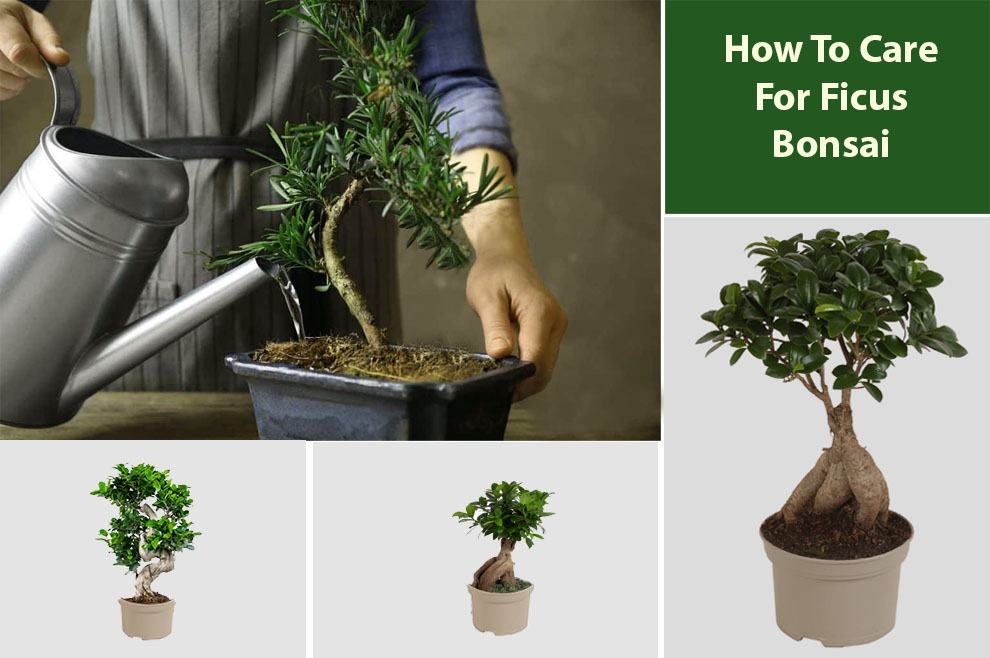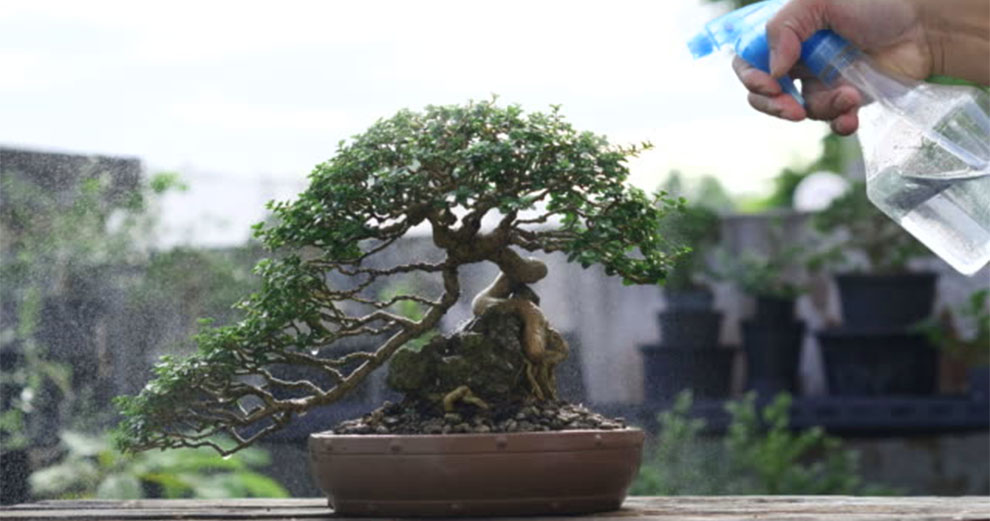Ficus Bonsai Tree Care – How To Make Your Ficus Bonsai Thrive?
Start with the basics of Ficus Bonsai Care i.e. planting it in specialized Bonsai soil, further giving it indirect bright light, and watering only when the top layer feels dry. Next comes the most important step – Pruning, to keep the plant in shape.

A Ficus Bonsai is a miniature tree created from a Ficus plant. It’s cultivated through pruning and shaping to mimic the appearance of full-sized trees.
Ficus Bonsai are ornamental and can be used for aesthetic purposes, interior decoration, and as a meditative hobby. They require meticulous care and can be a calming presence in indoor spaces.
Ficus bonsai tree care involves maintaining proper light (bright, indirect), watering when the top inch of soil is dry, and providing higher humidity levels. Keep temperatures between 60-75°F and use well-draining bonsai soil.
Fertilize with a balanced liquid fertilizer every 2-4 weeks during the growing season. Prune regularly for shape and size and repot every 2-3 years in spring.
Watch for pests and diseases, treating them promptly. During winter, reduce watering and withhold fertilizer for the tree’s rest period. Adapt care based on individual needs.
In this article, we shall provide the readers with a comprehensive overview of caring for Ficus Bonsai accurately.
Are Ficus Bonsai Hard To Care For?
Caring for a Ficus Bonsai requires attention and dedication, but it might not be overly difficult with the right knowledge. It demands proper lighting, humidity, and temperature control.
Consistent watering, pruning, and shaping are crucial. While not extremely challenging, it’s not ideal for complete beginners due to its specific needs. Regular observation and adjustment to its environment are key.
With proper care, a Ficus Bonsai can thrive and become a rewarding addition to your space, but it does involve a moderate learning curve and commitment to its unique requirements.
How To Take Care Of Ficus Bonsai
Caring for a Ficus Bonsai plant requires attention to various aspects such as watering, light, temperature, pruning, and soil. Here’s a comprehensive guide:
A. Which is the best-suited Ficus Bonsai soil?
The best-suited soil for Ficus Bonsai is a well-draining bonsai soil or a mixture of potting soil, perlite, and sand. Make sure the soil allows water to pass through easily to prevent root rot.
A typical bonsai soil mix for Ficus might consist of:
Akadama: A Japanese volcanic clay that retains moisture and provides good aeration.
Pumice: A lightweight, porous material that aids in water drainage and aeration.
Lava Rock: Another porous material that helps with drainage and adds stability to the soil.
Organic Matter: A small portion of organic material like pine bark or coconut coir can help retain moisture and provide nutrients.
A common mix ratio is approximately 1:1:1 part of akadama, pumice, and lava rock, with a small amount of organic material mixed in.
This blend ensures the soil retains enough moisture for the Ficus while preventing root rot caused by waterlogged soil.
B. Do Ficus Bonsai like direct sunlight?
Ficus Bonsai can tolerate some direct sunlight, but they generally prefer bright, indirect light. Direct sunlight, especially during the intense afternoon hours, can scorch their leaves and cause damage.
If you’re placing your Ficus Bonsai outdoors, consider providing filtered sunlight or morning sun with some afternoon shade to prevent leaf burn.
Don’t worry about how to care for Ficus Bonsai indoors, indoor Ficus Bonsai should be placed near a window with bright, filtered light.
If you notice that your bonsai is receiving too much direct sunlight and its leaves are starting to show signs of stress (such as browning or yellowing), consider moving it to a location with gentler light or providing shade during the hottest parts of the day.
Balancing light exposure is key to ensuring the health and vitality of your Ficus Bonsai.
C. How often do you water a Ficus Bonsai tree?

Watering frequency for a Ficus Bonsai depends on factors like size, pot, soil, humidity, and environment. Check soil moisture by feeling about an inch deep; water when dry.
Avoid overwatering to prevent root rot. Water thoroughly until it drains from the pot’s bottom. In the growing season (spring/summer), water every 2-3 days on average.
In dormancy (fall/winter), water them lesser—about once a week or when the surface is dry.
Adjust the frequency based on temperature, humidity, and the bonsai’s response. Observe signs like drooping leaves or dry soil. Personalize your watering routine for your specific Ficus Bonsai variety and conditions.
D. Where is the best place to put a Ficus Bonsai tree?
Ficus Bonsai care guidelines dictate that you are required to position your plant where it can receive bright, indirect light—essential for healthy growth.
Filtered sunlight near a window or morning sun with protection from intense afternoon rays is ideal. This setting supports photosynthesis, ensuring robust foliage and branches.
Stable indoor temperatures and humidity levels are key, while outdoors, offer partial shade to prevent leaf burn.
Placing it where its form is highlighted adds aesthetic value. Adapt its position based on your environment’s lighting, temperature, and humidity for optimal care, resulting in a visually captivating and thriving Ficus Bonsai.
E. What temperature can a Ficus Bonsai tolerate?
Ficus Bonsai trees can thrive in temperatures ranging from 60°F to 75°F (15°C to 24°C). While they can withstand variations, it’s essential to shield them from abrupt temperature changes.
Protect them from cold drafts and frost. During warmer months, you can move them outdoors, but make sure the temperature doesn’t drop below their tolerance range.
F. Does Ficus Bonsai need fertilizer?
Yes, proper Ficus Bonsai need regular fertilization during their active growth period, which is typically from spring to early autumn.
Apply a balanced liquid fertilizer every 2-4 weeks. Dilute it to half-strength to prevent over-fertilization.
During the dormant phase in fall and winter, reduce or suspend fertilization, as the tree’s growth slows down.
G. Can you wire a Ficus Bonsai tree?
Wiring is a common technique to shape Ficus Bonsai trees. Use soft aluminum or copper wire and apply it with care to avoid damaging the bark.
It’s best to wire during the growing season when branches are pliable. However, be attentive and check the wiring regularly, as Ficus trees grow relatively fast.
Adjust or remove the wire before it cuts into the branches, ensuring you maintain the desired shape while promoting healthy growth.
How Do You Prune A Ficus Bonsai Tree?
Pruning a Ficus Bonsai is essential for maintaining its shape and promoting healthy growth. It involves using sharp bonsai shears to selectively trim overgrown, unhealthy, or misshapen branches.
- Cut just above healthy buds or nodes at a slant to encourage new growth.
- Thin the crown by removing excess leaves and branches for improved light and airflow.
- Wire branches for shaping if needed, but avoid excessive pressure.
- Regularly assess the overall form, and avoid over-pruning to prevent stress. After pruning, ensure proper watering and care for recovery.
Remember that Ficus Bonsai trees tolerate pruning well, but it’s important not to prune too much at once. Gradual shaping and maintenance are key to a healthy and visually appealing bonsai.
When Should You Re-Pot A Ficus Bonsai?
You should generally re-pot a Ficus Bonsai every 2 to 3 years, usually in the spring. Repotting is essential for maintaining the health of the bonsai by refreshing the soil, preventing root congestion, and allowing for new root growth.
However, the exact timing can vary depending on the growth rate of your specific tree, the size of the pot, and the overall health of the bonsai.
Look for signs like slowed growth, roots emerging from the drainage holes, or the soil breaking down. Repotting is a delicate process, so ensure you have the right tools and follow proper techniques to avoid damaging the tree’s root system.
What Are The Pests On My Ficus Bonsai Tree?
If you wish to understand ‘How to care for a Ficus Bonsai tree?’ then you ought to know about the kind of pests and diseases that the tree is frequently affected by.
Ficus Bonsai can be susceptible to various pests and insects. Common ones include:
Aphids: Small, soft-bodied insects that cluster on new growth, sucking sap and causing distorted leaves.
Scale Insects: These pests look like small bumps on leaves and stems. They feed on plant sap, weakening the bonsai.
Mealybugs: White, waxy insects that cluster in protected areas. They also feed on plant fluids.
Spider Mites: Tiny arachnids that create fine webbing and cause stippling on leaves due to sucking sap.
Whiteflies: Small, winged insects that cluster on the undersides of leaves, draining sap and spreading diseases.
Fungus Gnats: Small flying insects that lay eggs in damp soil. Their larvae can damage roots.
Regular inspection is vital to catch infestations early.
It is recommended to use insecticidal soaps, neem oil, or other appropriate treatments to control these pests. Encouraging beneficial predators like ladybugs can also help keep pest populations in check.
Related: Juniper Bonsai Care | Bonsai Care in Winter
What Does Indoor Ficus Bonsai Tree Care Entail?
Here’s how caring for an indoor Ficus Bonsai is distinct and what additional considerations are needed:
Light: Indoor bonsai may need supplemental artificial lighting if natural light is insufficient.
Humidity: Indoor environments are typically drier, so indoor Ficus Bonsai benefits from increased humidity. Place the bonsai on a humidity tray with water and pebbles or use a room humidifier.
Air Circulation: Indoor air can be stagnant. Provide occasional gentle air movement for indoor bonsai to mimic the outdoor breeze.
Pest Prevention: Indoor bonsai plants might be more prone to pests due to reduced exposure to natural predators. Regular inspection is essential, and isolation from other plants can help prevent pest spread.
Pruning and Growth: Indoor bonsai may have slower growth due to limited light. Adjust your pruning and shaping schedule accordingly.
Fertilization: Indoor bonsai may require slightly different fertilizer formulations, as their nutrient needs can vary from outdoor bonsai plants.
Winter Care: Indoor Ficus Bonsai may not experience a true dormant period, so monitor their needs for water, light, and temperature consistently throughout the year.
